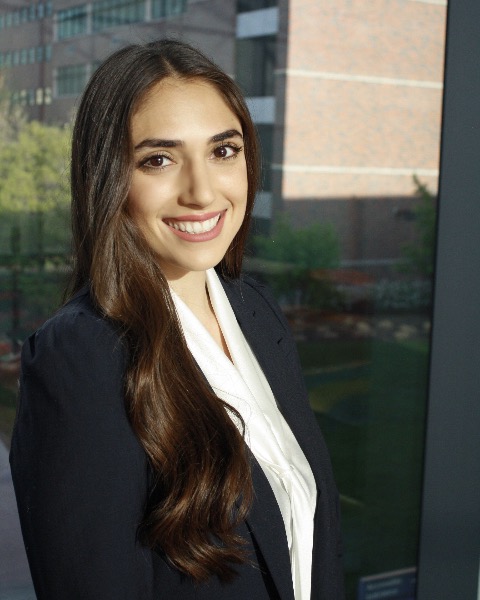Pediatric Neurology
Category: Abstract Submission
Neurology 1: Clinical Pediatric & Neonatal Neurology
547 - Psychosocial stressors and barriers to care for rural and Hispanic children with epilepsy and their families during the COVID-19 pandemic
Friday, April 22, 2022
6:15 PM - 8:45 PM US MT
Poster Number: 547
Publication Number: 547.139
Publication Number: 547.139
Shiva Pedram, University of Kansas School of Medicine, Overland Park, KS, United States; Stephanie J. Horton, Children's Mercy Hospitals and Clinics, Kansas City, MO, United States; Kathy Goggin, Children's Mercy Hospitals and Clinics, Kansas City, MO, United States; Vincent Staggs, Children's Mercy KC / University of Missouri-Kansas City, Kansas City, MO, United States; Ahmed Abdelmoity, Children's Mercy Hospitals and Clinics, Overland Park, KS, United States; Jean-Baptiste Le Pichon, Children's Mercy Hospitals and Clinics, Kansas City, MO, United States

Shiva Pedram, BA
Medical Student
University of Kansas School of Medicine
Overland Park, Kansas, United States
Presenting Author(s)
Background: Barriers to health care for children with epilepsy (CYE) can be significant, especially for minorities and families living in rural areas. During the pandemic these barriers were exacerbated by stay-at-home orders, school closings, loss of income, and anxiety over complications from COVID19.
Objective: This study was designed to assess the need for sustainable solutions and knowledge for healthcare providers to deliver care to CYE in rural underserved areas during the COVID19 pandemic. We explored environmental anxiety and stress in CYE families within three subgroups: Hispanic/non-Hispanic, Rural/Suburban, and Loss of Income/No Loss of Income.
Design/Methods: We created a survey to measure pandemic-related anxiety and barriers. The survey consisted of 4 sections: school, income, health, and family. The survey was given to 54 parents or caregivers of CYE who were English- or Spanish- speaking. Inclusion criteria included: Hispanic/non-Hispanic who reside in rural underserved areas or parents/caregivers of any ethnicity or race who are residents of a full-access suburb. Associations between Hispanic ethnicity, rural location, and loss of income and survey variables were assessed regression analyses.
Results: The study data indicate worse health care access and anxiety among Hispanic respondents and those who suffered income loss due to the pandemic. A large proportion of rural respondents were Hispanic and reported income loss, thus the results comparing underserved rural to suburban full access populations were better explained by the effects of ethnicity and income. Hispanic respondents of CYE reported twice as much anxiety with regards to the risk of COVID19 to CYE (60% Hispanic vs. 33% of non-Hispanic). Hispanics also reported the highest level of worry about maintaining access to their epilepsy providers during the pandemic (33% Hispanic vs. 8% of non-Hispanic).Conclusion(s): This study uncovered an urgent need for health access measures targeting Hispanic caregivers of CYE, especially those who lost income due to the pandemic. Anxiety regarding COVID19 was higher in this population, correlating with the higher disease burden amongst Hispanics as reported by the Center for Disease Control and other COVID19 studies. This study contributes to existing research by assessing the pandemic’s mental health effects on CYE families and their access to epilepsy care. The results of this study can be used to develop an educational program aimed at medical providers to improve care of CYE and address the stressors posed by COVID19.
CV Shiva PedramCV_Pedram_.pdf
Objective: This study was designed to assess the need for sustainable solutions and knowledge for healthcare providers to deliver care to CYE in rural underserved areas during the COVID19 pandemic. We explored environmental anxiety and stress in CYE families within three subgroups: Hispanic/non-Hispanic, Rural/Suburban, and Loss of Income/No Loss of Income.
Design/Methods: We created a survey to measure pandemic-related anxiety and barriers. The survey consisted of 4 sections: school, income, health, and family. The survey was given to 54 parents or caregivers of CYE who were English- or Spanish- speaking. Inclusion criteria included: Hispanic/non-Hispanic who reside in rural underserved areas or parents/caregivers of any ethnicity or race who are residents of a full-access suburb. Associations between Hispanic ethnicity, rural location, and loss of income and survey variables were assessed regression analyses.
Results: The study data indicate worse health care access and anxiety among Hispanic respondents and those who suffered income loss due to the pandemic. A large proportion of rural respondents were Hispanic and reported income loss, thus the results comparing underserved rural to suburban full access populations were better explained by the effects of ethnicity and income. Hispanic respondents of CYE reported twice as much anxiety with regards to the risk of COVID19 to CYE (60% Hispanic vs. 33% of non-Hispanic). Hispanics also reported the highest level of worry about maintaining access to their epilepsy providers during the pandemic (33% Hispanic vs. 8% of non-Hispanic).Conclusion(s): This study uncovered an urgent need for health access measures targeting Hispanic caregivers of CYE, especially those who lost income due to the pandemic. Anxiety regarding COVID19 was higher in this population, correlating with the higher disease burden amongst Hispanics as reported by the Center for Disease Control and other COVID19 studies. This study contributes to existing research by assessing the pandemic’s mental health effects on CYE families and their access to epilepsy care. The results of this study can be used to develop an educational program aimed at medical providers to improve care of CYE and address the stressors posed by COVID19.
CV Shiva PedramCV_Pedram_.pdf
